A trans-Neptunian object (TNO), also written transneptunian object, is any minor planet in the Solar System that orbits the Sun at a greater average distance than Neptune, which has an orbital semi-major axis of 30.1 astronomical units (au).
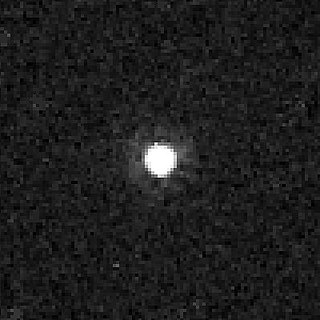
28978 Ixion (, provisional designation 2001 KX76) is a large trans-Neptunian object and a possible dwarf planet. It is located in the Kuiper belt, a region of icy objects orbiting beyond Neptune in the outer Solar System. Ixion is classified as a plutino, a dynamical class of objects in a 2:3 orbital resonance with Neptune. It was discovered in May 2001 by astronomers of the Deep Ecliptic Survey at the Cerro Tololo Inter-American Observatory, and was announced in July 2001. The object is named after the Greek mythological figure Ixion, who was a king of the Lapiths.
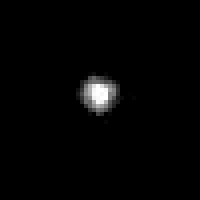
20000 Varuna (provisional designation 2000 WR106) is a large trans-Neptunian object in the Kuiper belt. It was discovered in November 2000 by American astronomer Robert McMillan during a Spacewatch survey at the Kitt Peak National Observatory. It is named after the Hindu deity Varuna, one of the oldest deities mentioned in the Vedic texts.
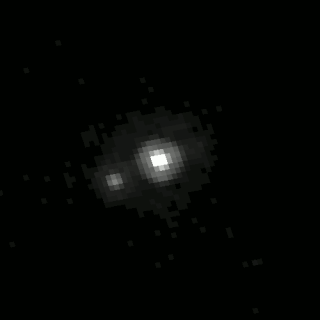
Orcus is a dwarf planet located in the Kuiper belt, with one large moon, Vanth. It has an estimated diameter of 870 to 960 km, comparable to the Inner Solar System dwarf planet Ceres. The surface of Orcus is relatively bright with albedo reaching 23 percent, neutral in color, and rich in water ice. The ice is predominantly in crystalline form, which may be related to past cryovolcanic activity. Other compounds like methane or ammonia may also be present on its surface. Orcus was discovered by American astronomers Michael Brown, Chad Trujillo, and David Rabinowitz on 17 February 2004.

Haumea is a dwarf planet located beyond Neptune's orbit. It was discovered in 2004 by a team headed by Mike Brown of Caltech at the Palomar Observatory, and formally announced in 2005 by a team headed by José Luis Ortiz Moreno at the Sierra Nevada Observatory in Spain, who had discovered it that year in precovery images taken by the team in 2003. From that announcement, it received the provisional designation 2003 EL61. On September 17, 2008, it was named after Haumea, the Hawaiian goddess of childbirth, under the expectation by the International Astronomical Union (IAU) that it would prove to be a dwarf planet. Nominal estimates make it the third-largest known trans-Neptunian object, after Eris and Pluto, and approximately the size of Uranus's moon Titania. Precovery images of Haumea have been identified back to March 22, 1955.

38628 Huya ( hoo-YAH; provisional designation 2000 EB173) is a binary trans-Neptunian object located in the Kuiper belt, a region of icy objects orbiting beyond Neptune in the outer Solar System. Huya is classified as a plutino, a dynamical class of trans-Neptunian objects with orbits in a 3:2 orbital resonance with Neptune. It was discovered by the Quasar Equatorial Survey Team and was identified by Venezuelan astronomer Ignacio Ferrín in March 2000. It is named after Juyá, the mythological rain god of the Wayuu people native to South America.
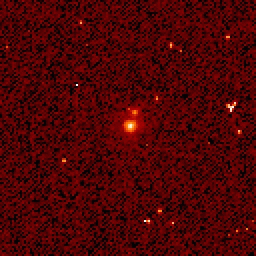
47171 Lempo, or as a binary (47171) Lempo–Hiisi (provisional designation 1999 TC36), is a trans-Neptunian object and trinary system from the Kuiper belt, located in the outermost regions of the Solar System. It was discovered on 1 October 1999, by American astronomers Eric Rubenstein and Louis-Gregory Strolger during an observing run at Kitt Peak National Observatory in Arizona, United States. Rubenstein was searching images taken by Strolger as part of their Nearby Galaxies Supernova Search project. It is classified as a plutino with a 2:3 mean-motion resonance with Neptune and is among the brighter TNOs. It reached perihelion in July 2015. This minor planet was named after Lempo from Finnish mythology.
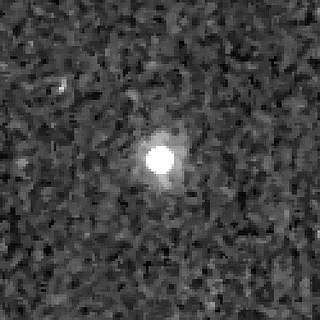
(84522) 2002 TC302 (provisional designation 2002 TC302) is a mid-sized trans-Neptunian object located in the outermost region of the Solar System. It was discovered on 9 October 2002, by American astronomers Mike Brown, Chad Trujillo and David Rabinowitz at the Palomar Observatory in California. The resonant trans-Neptunian object stays in a 2:5 resonance with Neptune. It has a reddish color, a rotation period of 56.1 hours and measures at least 500 kilometers (310 miles) in diameter.
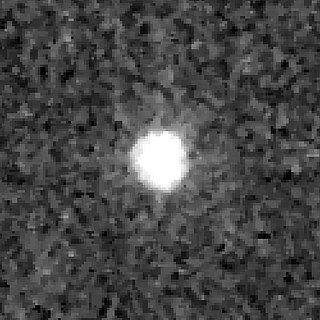
(55636) 2002 TX300 is a bright Kuiper belt object in the outer Solar System estimated to be about 286 kilometres (178 mi) in diameter. It is a large member of the Haumea family that was discovered on 15 October 2002 by the Near-Earth Asteroid Tracking (NEAT) program.
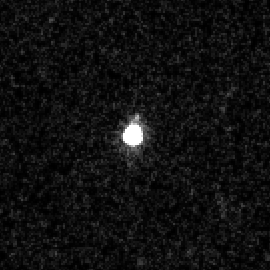
(208996) 2003 AZ84 (provisional designation 2003 AZ84) is a trans-Neptunian object with a possible moon located in the outer regions of the Solar System. It is approximately 940 kilometers across its longest axis, as it has an elongated shape. It belongs to the plutinos – a group of minor planets named after its largest member Pluto – as it orbits in a 2:3 resonance with Neptune in the Kuiper belt. It is the third-largest known plutino, after Pluto and Orcus. It was discovered on 13 January 2003, by American astronomers Chad Trujillo and Michael Brown during the NEAT survey using the Samuel Oschin telescope at Palomar Observatory.
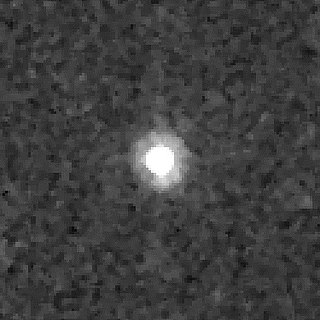
(84922) 2003 VS2 is a trans-Neptunian object discovered by the Near Earth Asteroid Tracking program on 14 November 2003. Like Pluto, it is in a 2:3 orbital resonance with Neptune and is thus a plutino. Analysis of light-curve suggests that it is not a dwarf planet.

15810 Arawn (provisional designation 1994 JR1) is a trans-Neptunian object (TNO) from the inner regions of the Kuiper belt, approximately 133 kilometres (83 mi) in diameter. It belongs to the plutinos, the most populous class of resonant TNOs. It was named after Arawn, the ruler of the underworld in Welsh mythology, and was discovered on 12 May 1994, by astronomers Michael Irwin and Anna Żytkow with the 2.5-metre Isaac Newton Telescope at Roque de los Muchachos Observatory in the Canary Islands, Spain.

229762 Gǃkúnǁʼhòmdímà (provisional designation 2007 UK126) is a trans-Neptunian object and binary system from the extended scattered disc, located in the outermost region of the Solar System. It was discovered on 19 October 2007 by American astronomers Megan Schwamb, Michael Brown, and David Rabinowitz at the Palomar Observatory in California and measures approximately 600 kilometers (400 miles) in diameter. This medium-sized TNO appears to be representative of a class of mid-sized objects under approximately 1000 km that have not collapsed into fully solid bodies. Its 100-kilometer moon was discovered by Keith Noll, Will Grundy, and colleagues with the Hubble Space Telescope in 2008, and named Gǃòʼé ǃHú.

Gonggong is a dwarf planet and a member of the scattered disc beyond Neptune. It has a highly eccentric and inclined orbit during which it ranges from 34–101 astronomical units from the Sun. As of 2019, its distance from the Sun is 88 AU, and it is the sixth-farthest known Solar System object. According to the Deep Ecliptic Survey, Gonggong is in a 3:10 orbital resonance with Neptune, in which it completes three orbits around the Sun for every ten orbits completed by Neptune. Gonggong was discovered in July 2007 by American astronomers Megan Schwamb, Michael Brown, and David Rabinowitz at the Palomar Observatory, and the discovery was announced in January 2009.
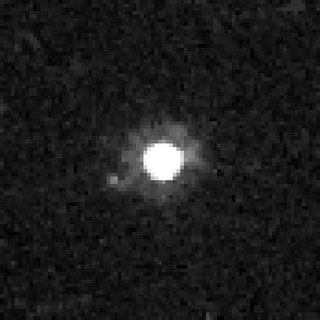
Quaoar is a large, ringed dwarf planet in the Kuiper belt, a region of icy planetesimals beyond Neptune. It has an elongated ellipsoidal shape with an average diameter of 1,090 km (680 mi), about half the size of the dwarf planet Pluto. The object was discovered by American astronomers Chad Trujillo and Michael Brown at the Palomar Observatory on 4 June 2002. Quaoar's surface contains crystalline water ice and ammonia hydrate, which suggests that it might have experienced cryovolcanism. A small amount of methane is present on its surface, which can only be retained by the largest Kuiper belt objects.
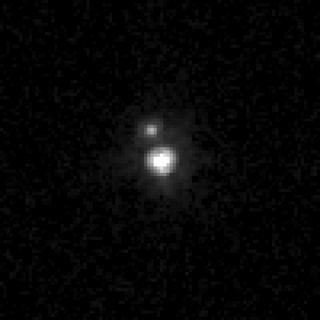
Vanth is a natural satellite or moon of the large trans-Neptunian dwarf planet 90482 Orcus. It was discovered by Michael Brown and Terry-Ann Suer using images taken by the Hubble Space Telescope on 13 November 2005. The moon has a diameter of 443 km (275 mi), making it about half the size of Orcus and the third-largest moon of a trans-Neptunian object. Vanth is massive enough that it shifts the barycenter of the Orcus–Vanth system outside of Orcus, forming a binary system in which the two bodies revolve around the barycenter, much like the Pluto–Charon system. It is hypothesized that both systems formed similarly, most likely by a giant impact early in the Solar System's history. In contrast to Orcus, Vanth has a darker and slightly redder surface that apparently lacks exposed water ice, resembling primordial Kuiper belt objects.
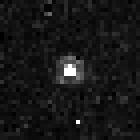
(82075) 2000 YW134 (provisional designation 2000 YW134) is a resonant trans-Neptunian object and binary system, located in the outermost region of the Solar System. It was discovered on 26 December 2000, by astronomers with the Spacewatch survey at Kitt Peak Observatory near Tucson, Arizona. The reddish object stays in a rare 3:8 resonance with Neptune. A smaller companion was discovered by the Hubble Space Telescope in October 2002. As of 2021, neither the primary body nor its satellite have been named.

(532037) 2013 FY27 (provisional designation 2013 FY27) is a trans-Neptunian object and binary system that belongs to the scattered disc (like Eris). Its discovery was announced on 31 March 2014. It has an absolute magnitude (H) of 3.2. 2013 FY27 is a binary object, with two components approximately 740 kilometres (460 mi) and 190 kilometres (120 mi) in diameter. It is the ninth-intrinsically-brightest known trans-Neptunian object, and is approximately tied with 2002 AW197 and 2002 MS4 (to within measurement uncertainties) as the largest unnamed object in the Solar System.

Xiangliu, full designation 225088 Gonggong I Xiangliu, is the only known moon of the scattered-disc dwarf planet Gonggong. It was discovered by a team of astronomers led by Csaba Kiss during an analysis of archival Hubble Space Telescope images of Gonggong. The discovery team had suspected that the slow rotation of Gonggong was caused by tidal forces exerted by an orbiting satellite. Xiangliu was first identified in archival Hubble images taken with Hubble's Wide Field Camera 3 on 18 September 2010. Its discovery was reported and announced by Gábor Marton, Csaba Kiss, and Thomas Müller at the 48th Meeting of the Division for Planetary Sciences on 17 October 2016. The satellite is named after Xiangliu, a nine-headed venomous snake monster in Chinese mythology that attended the water god Gonggong as his chief minister.




















